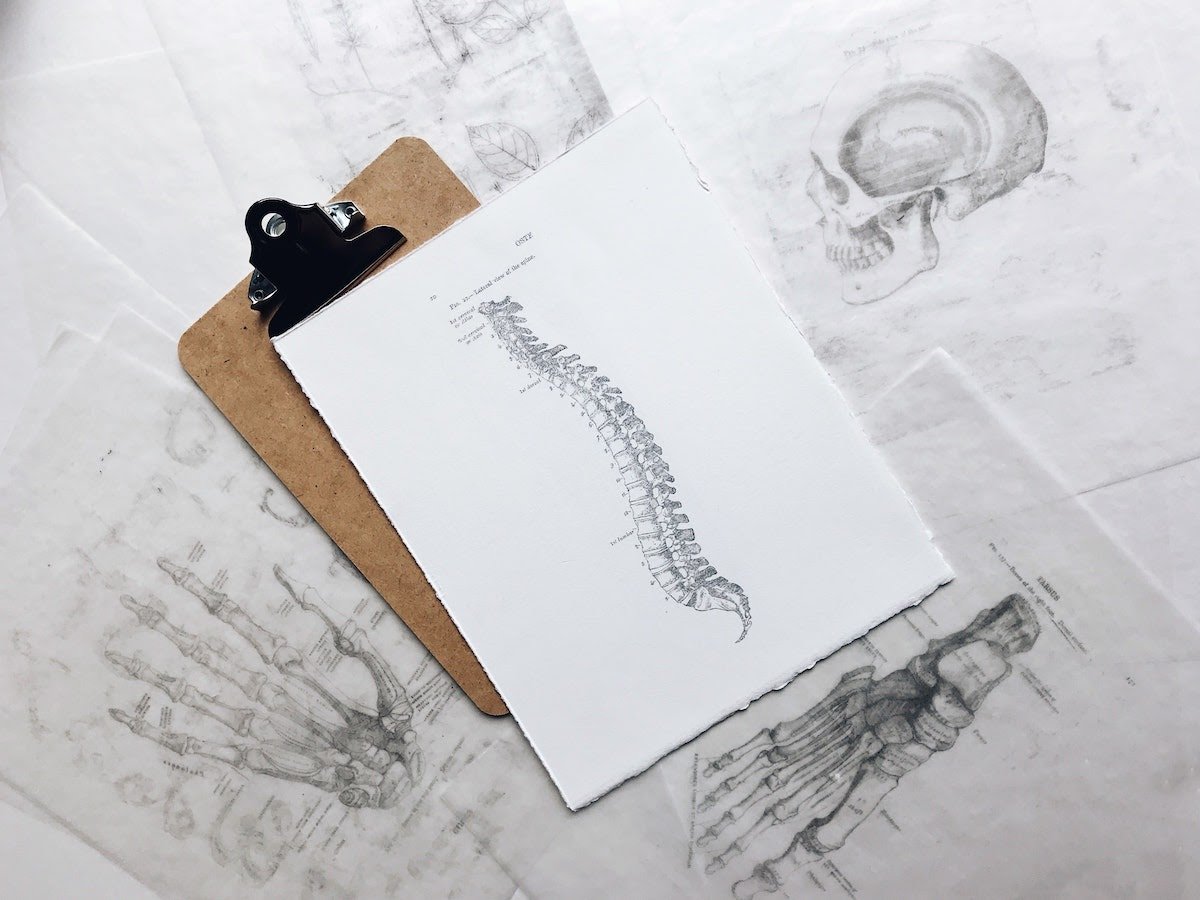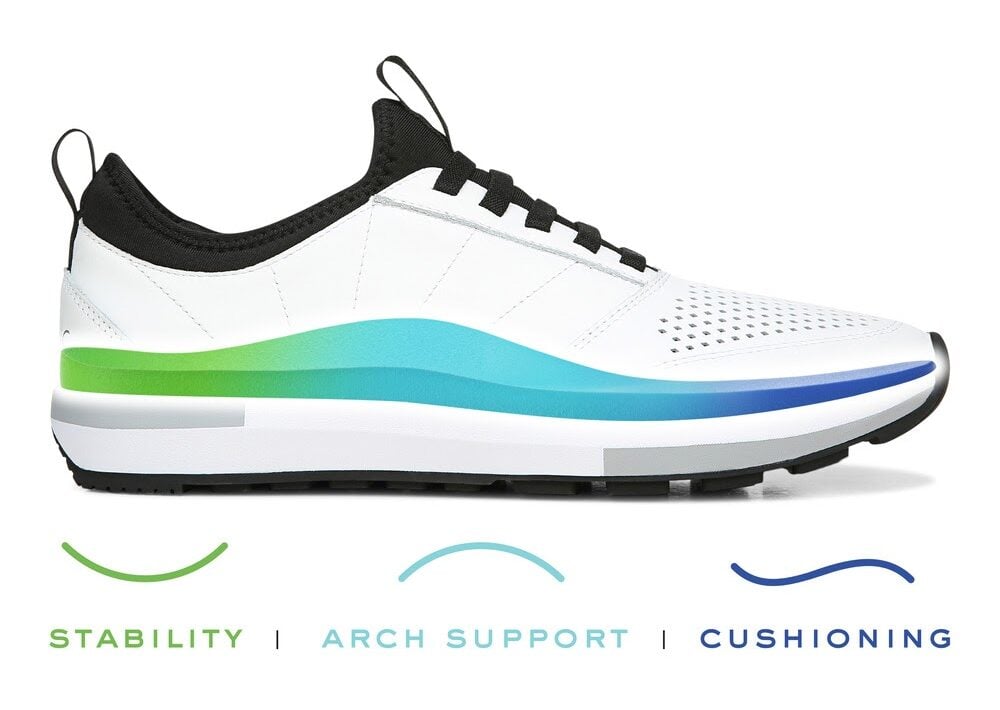
When you hear the word chiropractor, plantar fasciitis is probably the last thing that comes to mind.
Despite this disconnect, an inflamed plantar fascia can actually have a lot to do with improper spinal alignment. Many people naturally treat each part of their body separately, but the truth is that the human body is one working machine. And what happens when a single gear in a machine stops working? The whole system gets thrown out of whack.
The same thing can happen with the spine. When your alignment is off, the rest of the body suffers. Moving around with improper alignment will only lead to greater problems—including inflammation of the plantar fascia. That’s where the help of a professional comes in. While getting a pair of shoes for plantar fasciitis is a great place to start, read on to learn all the ways a chiropractor can also help with plantar fasciitis!

What is Spinal Alignment?
To understand why plantar fasciitis and chiropractic treatment go hand-in-hand, it’s important to recognize what spinal alignment really is so that you know how it can help your signs of plantar fasciitis.
In an ideal world, your spine would resemble a completely straight line. The skull would be level with the chest and the chest with the pelvis—this positioning would create a perfectly stacked spinal column. Unfortunately, we don’t live in a perfect world, and many people have abnormal spinal alignment.
You may be wondering: what exactly is abnormal alignment, though? How does it pertain to plantar fasciitis? Well, an abnormal alignment will often look like a curved spine. This spinal shape is known as sagittal alignment, or—in layman’s terms—bad posture. When bad posture becomes severe, the way you walk is impaired. If you’re putting uneven pressure on the feet and ankles or taking asymmetrical steps, your ligaments are going to react accordingly—enter: a painful case of plantar fasciitis.¹
What Do Chiropractors Do For Plantar Fasciitis?
Can a chiropractor help plantar fasciitis?
The short answer is: yes. Chiropractic care is one of the most effective treatments for healing an inflamed ligament. If you’ve ever received alignment from a chiropractor before, it’s important to note that plantar fasciitis treatment is going to look a little different. Here’s how it works:
- Spinal signals – First, a chiropractor is going to perform a standard spinal alignment that targets the nerves in your feet. Plantar treatment starts in the spine because the arches of your foot are made from soft tissue. This soft connective tissue responds to nerve signals sent from the spine.² Therefore, if the spine is happy and sending the right signals, the feet will follow, and you could experience natural pain relief.
- Lower back – Perhaps the most important part of the spine—at least in terms of your feet—is the lower back. This area sends the most signals to the soft tissue in the feet, and the lower back’s proximity to the legs is another reason why it must be properly aligned. Most chiropractic treatments will involve shaping the lower spine and straightening it out from a curved shape, which many people develop over years of slouched posture.
- Feet adjustments – Adjustments don’t stop at the spine. For serious cases of plantar fasciitis, a chiropractor may perform an adjustment on the foot or the ankle. This will straighten out the bones and joints, relieve pressure off the heel, and help reduce pain.³
- Stretching – A chiropractor’s knowledge isn’t limited to just bones. Since the plantar fascia is a ligament itself, working with the muscles can be beneficial during a chiropractic adjustment. Plantar fasciitis can cause cramping and tearing of the ligaments and muscles, but routine and thorough stretching can strengthen these fibers and protect them from further damage.
Your practitioner may perform a variety of these stretches to the arch and ball of your foot, as well as the ankle. Don’t be surprised if you’re sent off with a little homework, as well. Doing nightly stretches—when recommended by a chiropractor—can help manage pain and speed up the healing process.⁴
The bottom line is that many chiropractors have experience in treating plantar fasciitis. Not only can stretching and adjustments of the foot help relieve pressure and sharp pain, but an overall spinal adjustment will address the root of the problem. With better posture will come healthier movement and thus less damage to the ligaments in the foot.
What Are Adjustments?
All this talk of adjustments may be a little confusing for chiropractic newcomers. To get a better idea of what chiropractic care looks like, here’s what you need to know about adjustments:
The spinal column is made up of vertebrae. When the spine is stacked in an abnormal way, these vertebrae can become dislodged, crooked, and prevent proper blood flow.⁵ When a chiropractor performs an adjustment, they are essentially pushing the vertebrae back into place. This process will involve popping and cracking of joints, and a patient will typically feel a relieving, lightweight sensation.⁶
Feet and ankles, however, do not have vertebrae. This means adjusting these areas will involve different tactics. Since the feet are made up of many small bones, it’s possible for multiple joints to fall out of alignment on any given day. A chiropractor can help move these joints back into place and redistribute the weight being put on each foot.⁷ When a chiropractor adjusts your feet or ankles, you may feel:
- Your joints open up
- Your muscles elongate
- The position of your foot straightening out
What Stretches Are Best For Plantar Fasciitis?
While you may not be able to perform a full chiropractic adjustment on yourself, daily stretching is a wise way to treat plantar fasciitis at home. Understanding how to prevent plantar fasciitis can often start with simple stretching. Some of the best stretches for the arch of the foot include:
- Calf stretch – Tight leg muscles, specifically tight calves, can often cause cramping throughout the foot and ultimately cause or worsen plantar fasciitis. To help stretch out your calf and foot muscles, try lying down or sitting sticking your leg straight out. From there, use a belt, resistance band, or rope and loop it around the bottom of your foot. Gently pull on the ends of your belt until you feel a nice stretch through your calf, arch, and even your toes.
- Arch roll – For this stretch, you can use a tennis ball, foam noodle, or frozen water bottle. Place your item of choice under the arch of your foot and gently roll it back and forth. This is an easy technique you can perform even before getting out of bed in the morning.⁸
- Toe raises – When you have plantar fasciitis, raising your toes can seem like an impossible task. Stacking a towel or two to create a soft, elevated surface, however, can make this stretch a little easier. Step your toes on the towel and slowly lower your heels to the ground. This will gently stretch out the plantar fascia and relieve pain in the arch and ball of the foot.
Basically, any movement that carefully stretches your arch ligaments can help relieve plantar fasciitis pain. Always remember to start slow when working with an inflamed plantar, and don’t push too hard if you’re experiencing discomfort. If stretching is a bit too intense during the early stages of your condition, there are other treatment options.
Other Ways to Treat Plantar Fasciitis
Chiropractic care is just one of many treatments for plantar fasciitis. If you’re interested in other methods of healing, here are some of the most common ways plantar fasciitis sufferers deal with plantar fascia inflammation:
- Pain medication – An over-the-counter analgesic, like Advil or Tylenol, is an easy way to reduce inflammation and get pain relief. Since inflammation can lead to greater damage, getting this reaction under control should be the first step before attempting to put pressure on the foot.
- Ice and heat – Ice can do wonders for an inflamed ligament. Cooling down the area can numb the pain, calm the nerves, and kick off the healing process. Similarly, targeted heat treatment can help relax the muscles and prevent further cramping, which may occur when walking or running.
- Orthotics – Prescription or over-the-counter orthotics may help relieve pain associated with plantar fasciitis. Proper arch support is crucial for even weight distribution on the foot, and adding extra support with a shoe insert can make daily life more manageable.
- Compression socks – Do compression socks help plantar fasciitis? Yes! While compression socks are commonly worn to reduce ankle swelling and varicose veins, they can also be used to treat plantar fasciitis. Moderate compression during the day can inhibit inflammation, prevent swelling of the plantar fascia, and provide additional support when walking around without shoes.
- Proper footwear – The best way to treat and prevent future cases of plantar fasciitis is sporting the proper footwear. When the foot is supported by a comfortable, functional, and cushioned shoe, the body’s alignment will naturally adjust itself. If you’re finding that plantar fasciitis is a common issue, you may want to opt for a new pair of everyday shoes.
Hopefully, after incorporating these tips into your routine, along with visiting a chiropractor, you will start to experience signs plantar fasciitis is healing.
Are you struggling to find footwear that offers support without sacrificing style? Vionic can help.

Vionic: The Support You Need
Here at Vionic, we understand the pain of plantar fasciitis. Being confined to a pair of orthotics can severely limit your shoe game—but Vionic footwear can help you ditch the Dr. Scholl’s.
Every pair of Vionic shoes come with our patented Vio-Motion footbed. With a trifecta of arch support, cushioning, and heel stability, Vionic footwear is a plantar fascia paradise. From stilettos to sandals, we’ve got a pair for any occasion.
Say goodbye to foot pain, and switch to Vionic footwear today!
Sources:
1.”How Chiropractic Helps People Who Suffer from Plantar Fasciitis”. Gonstead Chiropractor.
https://gonsteadchiropracticcenter.com/how-chiropractic-helps-people-who-suffer-from-plantar-fasciitis/
2.”How Chiropractors Can Fix Plantar Fasciitis”. Foot Levelers. https://www.footlevelers.com/blog/2019/05/14/how-chiropractors-can-fix-plantar-fasciitis/
3.Casey Runnels. “3 Ways Chiropractic Care Can Help Treat Plantar Fasciitis”. Runnels Chiro. https://www.runnelschiro.com/3-ways-chiropractic-care-can-help-treat-plantar-fasciitis/
4.Steven Yeomans. “Subluxation and Chiropractic”. Spine Health. Oct 7, 2009, https://www.spine-health.com/treatment/chiropractic/subluxation-and-chiropractic
5.Steven Yeomans. “Chiropractic Adjustment”. Spine health. March 14, 2013, https://www.spine-health.com/treatment/chiropractic/chiropractic-adjustment
6.”Ankle and Foot Pain”. Core Chiropractic.net. https://www.corechiropractic.net/articles/ankle-and-foot-pain/
7.Treacy Colbert. “Plantar Fasciitis Stretches to Soothe Heel Pain”. Healthline. Updated on September 17, 2018, https://www.healthline.com/health/fitness-exercise/plantar-fasciitis-stretches#other-tips
8.Treacy Colbert . “Plantar Fasciitis Stretches to Soothe Heel Pain”. Healthline. Updated on September 17, 2018, https://www.healthline.com/health/fitness-exercise/plantar-fasciitis-stretches#other-tips


Leave a Reply